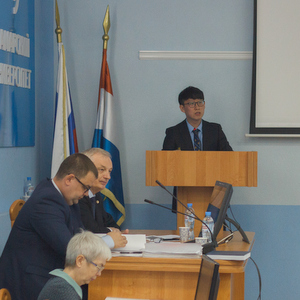Dong Jae, a postgraduate student from China, successfully defended his thesis for the degree of Technical Sciences Candidate at Samara National Research University. The thesis is the result of the work of the joint Russian-Chinese laboratory "Space Tether Systems". It has been operating on the basis of Samara University and Northwestern Polytechnical University (Xi'an, China) since 2015.
The work of Dong Jae is devoted to analyzing the dynamics and developing methods for controlling the motion of a low-orbit tether system when moving through the atmosphere at various stages — deployment, operation and etc. The theoretical grounds for creating orbital tether systems were studied by a postgraduate student under the guidance of Professor of Samara University Software Systems Department Yuriy Zabolotnov.
"This topic is extremely interesting to our Chinese colleagues. This interest has resulted in a joint laboratory. At Samara University it operates on the basis of Space Engineering Department within the block of disciplines "Theory of Movement and Flight Dynamics," – said Professor of the Department, Head of the Laboratory Sergey Ishkov. – A scientific research should end with practical implementation, but this topic is very complex. Therefore, at first, we offer Chinese postgraduate students to cope with "simple" tasks on the use of tether systems. This is, first of all, the development of a special tether system for a nanosatellite that could provide the orbital orientation of a spacecraft".
"I studied the theory of tether systems and flight dynamics. The idea of deploying a tether in space and using it either to slow down the vehicle or to drop a capsule with information seemed to be quite simple, but its implementation in practice requires many factors, most of which can be verified theoretically before the testing", – said Dong Jae, who received a certificate of Technical Sciences Candidate. He intends to continue his further career in the laboratory of the Chinese University.
The delegation of Northwestern Polytechnical University, which came to the defense of a Chinese postgraduate student, consisting of Professors Wang Wei, Wang Changqing, and Deputy Director of Science at the Institute of Automation Li Ayjun, emphasized that education, obtained at Samara University is highly valued in China.
The delegation and Samara University scientists discussed the development of the scientific activities of the joint laboratory, the development of joint programmes for the training of bachelor’s degree, master’s degree and postgraduate students of two universities. They also agreed to continue joint research in the field of tether systems and chose the topics of the next thesis for Lu Khonshi, who studies at the postgraduate school of Samara University and for Chen Shumin, who will come to study at Samara University postgraduate school in September 2019.
The visit of the Chinese representatives ended with the signing of a protocol of intent on joint work between Samara University and Northwestern Polytechnical University.
For reference
Tether systems is the current direction in modern astronautics. One of the most vivid examples of the use of a tether in space is the descent of the payload from the orbit without using a braking propulsion system.
The Orbital Tether System (OTS), consisting of two spacecrafts – the base spacecraft and payload – descended capsule, connected by a tether. The OTS is a promising tool for the solving of many problems in space. These include such tasks as creation of artificial gravity on board a spacecraft consisting of a bundle of two bodies, creation of a small electrodynamic thrust caused by the interaction of a conductive tether with the Earth’s magnetic field, and descending of the payload to the Earth’s surface without using thrust.
The OTS was first described over 100 years ago in the book of K.E. Tsiolkovsky "Dreams of the Earth and the Sky". It proposed the idea of creating artificial gravity on a spacecraft connected by a chain with a counterweight of equal mass. Moreover, the entire system was driven into rotation around its mass centre.
From a practical point of view the task of payload descending onto the surface of the Earth without a braking impulse is important.
Ekaterina Ivanushkina
 RU
RU  EN
EN  CN
CN  ES
ES 